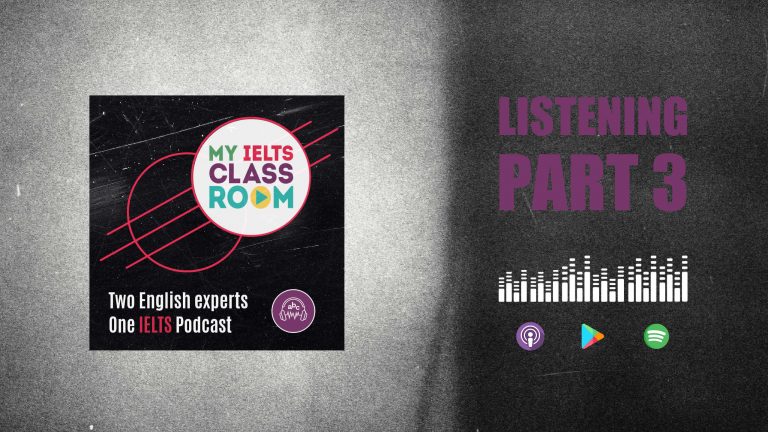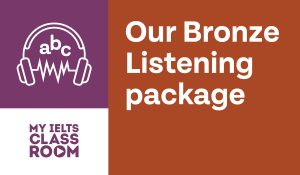
IELTS Listening Part 3
Many students find IELTS Listening Part 3 difficult. There are a number of reasons for this, which you hopefully remember from our IELTS Listening 101 episode: there are more than two voices, the questions usually focus on the outcome of a discussion in which many views are offered, and you may also be asked to locate a person’s feelings (and we all know that feelings are much harder to find than facts!).
So, in today’s episode, Nick and I try to make Part 3 slightly easier by going through FOUR of the common “tricks” used by IELTS test writers so that you can avoid being fooled by them.
How do we know the tricks? Well, remember, I am a trained exam writer, so while at night I help IELTS students pass the test, during the day, my job is to write the exams that you hate! That means I can show you exactly what I do when I write my exams to “hide” the right answers and confuse students – wha ha ha ha ha (that is my evil laugh!).
This is an interactive episode so please have a pen and piece of paper ready so that you can join in the activities.
Below, you can find a summary of the episode, which includes all of the links to useful materials and the times of each part of the discussion (so you can go directly to the part you want to listen to). You can also find every episode of the podcast here 🚀
Subscribe to My IELTS Classroom podcast on Apple podcasts here
Subscribe to My IELTS Classroom on Google podcasts here
My IELTS Classroom Podcast Episode 9 Summary: IELTS Listening Part 3

00:00 – 03:42 Introduction (Shelly’s got some new plants and we have some new information about the IELTS Indicator test)
04:03 – 07:14 Basic Information about Listening Part 3 While Parts 1 and 2 of the listening exam are focused on everyday interactions, in Part 3 we move to an academic context. And, for part three that means listening to two or three people having a conversation in an academic context. There are a number of reasons why many students find Part 3 the most difficult:
- It can be confusing when you are listening to hear 2 or 3 different voices, especially as the questions often give names of speakers, so you have to remember who everybody is!
- The questions often focus on what a person thinks or feels about a topic. Understanding feelings is much harder than listening for pure facts as you often have to induce what the speaker is feeling from their words (i.e. they won’t tell you directly). To make things even harder, speakers often change their opinion throughout the conversation, so you have to make sure that you understand their FINAL view.
- Part 3 is the only part of the exam where you may have to understand sentences from 2 or 3 speakers to find the answer. In other words, you will need to be able to follow the conversation to find the agreement that the speakers come to (which is difficult!).
06:53 – 10:24 What are we going to do in today’s podcast? In today’s lesson, I want to train you to think like an exam writer by showing you some of the “tricks” that IELTS uses to make the questions in this section difficult. Well, they aren’t really tricks – they are well-founded Academic techniques that test writers use to accurately assess your score! To do this, we are going to analyse Part 3 from Cambridge IELTS Book 9, Test 1. Yes, the one with Hiroko and Spiros!!!!!

10:46 – 21:12 The rapid-fire keywords trick! OK, so if you are an exam writer, the first tool in your “student confusion kit” is what I call the “rapid keyword trick”. This is a very simple tactic. You are going to give the student a multiple choice question with lots of clear keywords. Then, in listening, one of the speakers will use ALL of those keywords in quick succession.
Why? Well, this makes it impossible to find the answer if you are just listening for the keywords (or as we say, if you are listening for “gist”). In other words, you will only be able to find the answer if you understand the full meaning of the dialogue! In the episode, we will look at this question to analyse exactly how this trick works:

You might find it useful to look at the tape-script later to identify the keywords from the question that were given to us in the conversation:


21:13 – 29:16 The synonyms trick! For me, this trick is the absolute opposite of the previous one. This time, instead of giving the student all of the keywords in the multiple choice question, we are going to give them almost NO key words. Instead, we will give them a paraphrase of the answer in the typescript. Why? Again, we want to stop lower-level students from finding the answer using just one or two words.
Also, to make things even trickier, we won’t just paraphrase the answer, we will also add paraphrases for some of the distractors too! That way, students cannot just use the absence of a keyword as a way to find the answer!!! In the episode, we will look at this question to analyse exactly how this trick works:

29:17 – 35:33 The have you read the question properly trick! I love using this trick as it is so simple but so effective. All the exam writers do here is provide you with a sentence that directly matches one of the possible answers, but is talking about a different topic. For example, let’s imagine this is the question:
What does John like about his cat?
A its size
B its colour
C its behaviour
To use this trick, in the dialogue we would ask John to say:
I have so many animals that I love so much. My dog is a really lovely dark chestnut brown, which I love, although it doesn’t behave as well as my cat.
You would be surprised how many students would choose option 2 for this question, even though it is John’s DOG who is “a really lovely dark chestnut brown” not his cat. This may seem like a simple example on paper, but you will find this trick used again and again in the test. In the episode, we will look at this question to analyse exactly how this works:

You might find it useful to look at the tape-script later to see how weak students (or those who are aren’t fully concentrating) can be tricked here:


35:34 – 42:53 The several speakers trick! As I mentioned in the introduction, to answer some questions, you will have to follow the words of multiple speakers. In other words, it’s not enough to be able to understand one speaker, you have to be able to follow the full thread of the conversation. There are several ways the test writers can use this to “hide” an answer:
- The answer to a question can depend on just one word of agreement or disagreement i.e. there may be two possible options that the group are discussing and it is only in the final word that they all agree on one.
- Different members of the group can offer one of the multiple choice options to the speaker for them to consider so weak students will hear this and think it is the correct answer.
In the episode, we will look at this question to analyse exactly how this trick works:

42:54 – END How to practice listening properly. When you practice an exam in the Cambridge books, you should always analyse your results. This should be relatively easy for listening because Cambridge supplies the tape-script for each test at the back of each book with the relevant section of the conversation underlined. If you get an answer wrong, try to work out what tricked you – was it the rapid-fire keywords, or did you miss a synonym, or did you get lost in the middle of a conversation? The more you can understand your errors, the better your chance of getting a high score in your next attempt!
Would you like expert help you improving your Listening?
We offer a 5-day intensive course for IELTS test-takers every month that covers all aspects of listening, from how to approach every type of question, to how to use key words to follow a lecture, and avoid the distractors in Multiple Choice questions. Even better, with every course having no more than 8 students and being run by an ex-examiner, you will be getting personalised advice that is guaranteed to help you to improve your score.
Find out more about the course and how it can help you hit your target score here.

